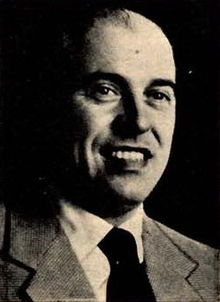Carlo Ponti (Carlo Fortunaro Pietro Ponti)

Carlo Ponti was born in Magenta, Lombardy and studied law at the University of Milan. He joined his father’s law firm in Milan and became involved in the film business through negotiating contracts. Ponti attempted to establish a film industry in Milan in 1940 and produced Mario Soldati’s Piccolo Mondo Antico there, starring Alida Valli, in her first notable role. The film dealt with the Italian struggle against the Austrians for the inclusion of northeastern Italy into the Kingdom of Italy during the Risorgimento. The film was successful, because it was easy to see “the Austrians as Germans” during World War II. As a result, he was briefly jailed for undermining relations with Nazi Germany. Ponti accepted an offer from Riccardo Gualino’s Lux Film in Rome in 1941, where he produced a series of commercially successful films featuring the comedian Totò. In 1954 he had his greatest artistic success with the production of Federico Fellini’s La strada. However, Fellini denied Ponti’s role in its success and said that “La Strada was made in spite of Ponti and De Laurentiis”. Carlo Ponti produced Boccaccio ’70 in 1962, Marriage Italian Style in 1964, and Yesterday, Today and Tomorrow in 1965. He produced his most popular and financially successful film, David Lean’s Doctor Zhivago, in 1965. He subsequently produced three notable films with Michelangelo Antonioni, Blowup in 1966, Zabriskie Point in 1970 and The Passenger in 1974.
Carlo Ponti owned works by, among others, Picasso, Georges Braque, Renoir, René Magritte (including his Lumière du pole from 1927), Salvador Dalí, Henry Moore (including his Figure from 1933), Barbara Hepworth, Giorgio de Chirico and Canaletto. His collection was renowned for containing ten works by Francis Bacon. These included examples from his early Van Gogh series, triptychs, self-portraits and pope paintings, which were rarely publicised or lent to public exhibitions. In 1977 the Bacon paintings, then valued at an estimated $6.7 million, were seized and turned over by the Italian government to the Pinacoteca di Brera in Milan; thirty-three sketches by George Grosz went to a museum in Caserta. When Ponti reached a deal with the Italian government and was cleared of the charges brought against him in 1990, he regained possession of 230 confiscated paintings. At some point, the collection is said to have been split between Ponti and Loren. Over the years, several works have been sold privately. In 2006 two Bacon paintings that had previously been in the Ponti collection were exhibited in an exhibition at the Gagosian Gallery in London. One, a vertical composition of four self-portraits, had already been sold to the American collector Steven A. Cohen. In 2007 another pope painting by Bacon, sold by Ponti in 1991, was sold in a private deal brokered by Acquavella Galleries in New York for more than £15 million. That same year, Study for Portrait II (1956) was consigned by Loren at Christie’s; it was auctioned for the record price of £14.2 million ($27.5 million).
Born
- December, 11, 1912
- Italy
- Magenta, Lombardy
Died
- January, 10, 2007
- Geneva, Switzerland
Cemetery
- Cimitero di Magenta
- Magenta, Lombardy
- Italy



